British Special Service Squadron – July 1924
- View news filtered by: Interwar
- View news filtered by: Navy Organisation
- View news filtered by: Specialisms
- View news filtered by: Units & Squadrons
- View news filtered by: British Special Service Squadron
- View news filtered by type: Blog
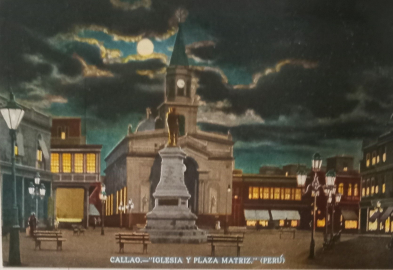
In this ongoing blog series, the National Museum of the Royal Navy is following the route of the British Special Service Squadron during the centenary of its voyage. In this entry we discuss its travels down the West Coast of the United States of America where the battle cruisers and light cruiser squadron parted company then on taking different routes.
San Francisco: 7 July
"Until quite recently San Francisco was most definitely anti-British, a very large proportion of the population being German and Irish Americans. So much was this the case that a British flag could not be displayed in the city. Our arrival found the whole city lavishly decorated with flags, among which the union Jack and White Ensign largely predominated". (Vivian, J. 1926.)
Thousands of people had been waiting on the hills above the harbour, looking towards the Golden Gate since midday. A fog had started rising, which was common in the region, when HMS Hood first appeared, moving out of the mist. One of the spectators was Phyllis Marquiss-Munro, the President of the San Francisco Women’s Press Club who later wrote:
"Majestically and slowly, H.M.S. Hood sailed into the bay, followed by the five warships in single file. The spectators held their breath, then simultaneously from a thousand throats, rose a deafening cheer." (Phyllis Marquiss-Munro, 19 July 1924, The Museum of the City of San Francisco).
As it sailed in, the squadron was met by the flagship, battleship USS California, while they gave reciprocal gun salutes. USS Tennessee, Idaho, Mississippi and two destroyers completed the American battle squadron stationed there.
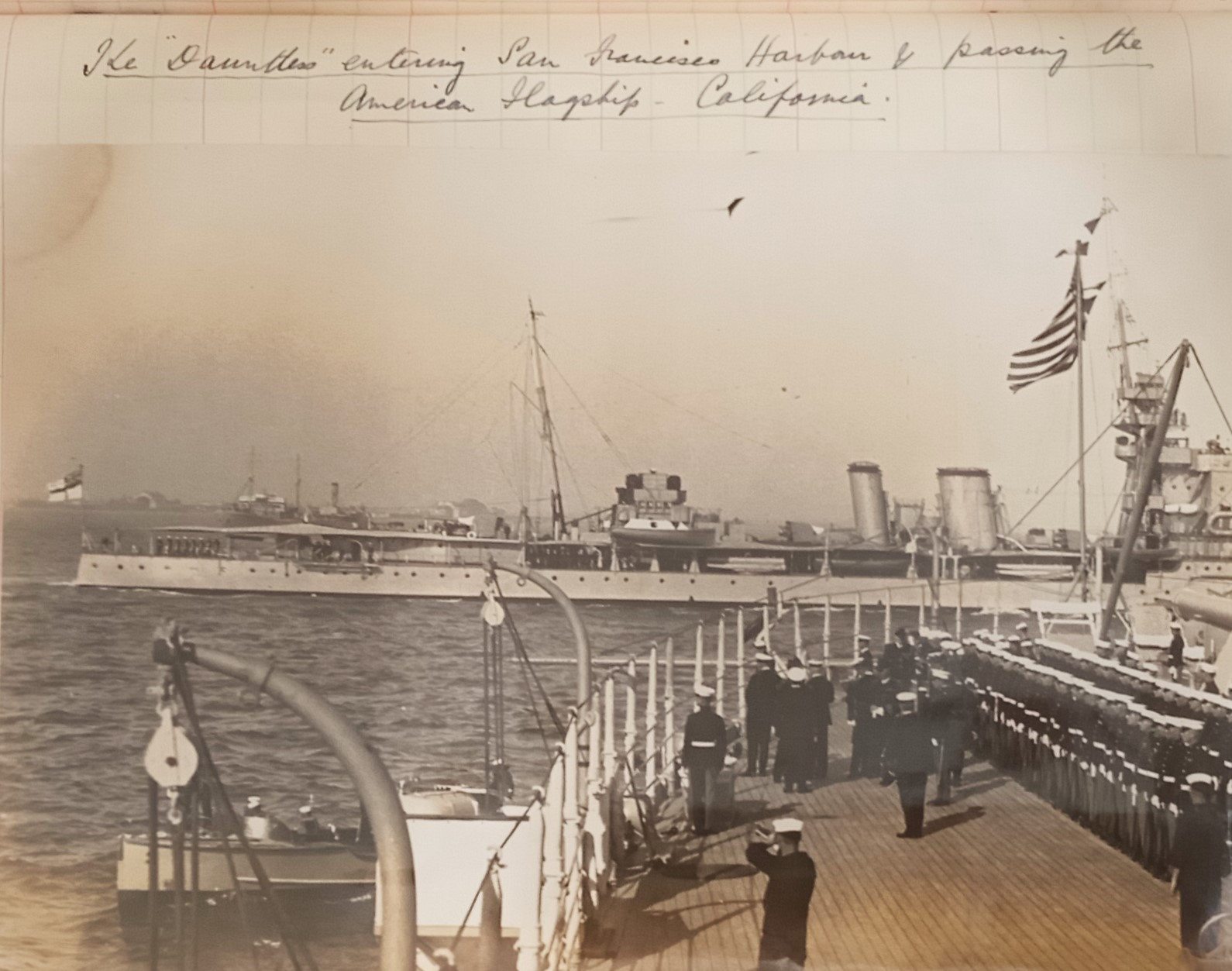
San Francisco was the only other stopping point outside the British Empire after Honolulu, both of which were planned as refuelling stops. As at Honolulu, California was subject to Prohibition regarding the sale of alcohol. Commander John Vivian from HMS Hood noted:
"...the squadron went 'dry' as a compliment to our hosts, and this action was much appreciated by the authorities. The only 'dry' spots in California however, seemed to be the British and United States ships!" (Commander John Vivian, HMS Hood)
Commander Vivian was not the only person to notice this. Wilfred Woolman, from HMS Repulse attended a dinner party where:
"...we had not long to wait before they proceeded to show us what a ‘dry’ country America is. A round of excellent cocktails appeared… to be immediately followed by another". (Wilfred Woolman, RNM 1999/31)
This was similarly commented on by Captain Round Turner of HMS Repulse:
"...the boot-legging is as open as anything; when we were out one day we passed a steamer lying too and discharging immense barrels into launches along-side" (Captain Round Turner, HMS Repulse, RNM 2015/175/4)
The British warrant officers were hosted at a buffet lunch on USS Tennessee by the American warrant officers. The Royal Navy ratings, colloquially known as ‘Jack Tars’, were granted shore leave and were shown the sights by their counterpart ‘Gobs’ (the American slang used within the navy to refer to sailors).
"Ashore, Jack Tar revelled in the kindly hospitality of this wonderful city. “Jack and the Gobs,” were the best of pals, dating from the fraternizing of the two mighty fleets during the great world war. On every street they were seen together, Jack Tar in his blue jersey and wide trousers, tipped by the strange pancake hats; standing open-eyed and wondering whilst a witty “Gob”, his little pudding basin hat tilted at a rakish angle, tells wild and woolly stories of the early days of the Golden West". (Phyllis Marquiss-Munro, 19 July 1924, The Museum of the City of San Francisco)
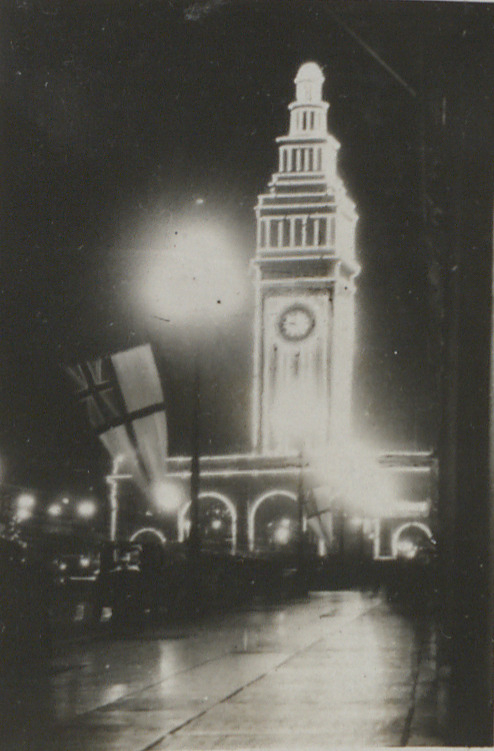
Departure from San Francisco: 11 July 1924
The squadron weighed anchor at 6:30am, sailing down the West Coast of America towards the Panama Canal. The Light Cruiser Squadron were taking a different route around South America while the battle cruisers and HMAS Adelaide, which retained the name Special Service Squadron, were going via Central America and the Panama Canal.
In advance of the separation, Rear Admiral Brand with the light cruisers sent a message to Vice Admiral Field in HMS Hood.
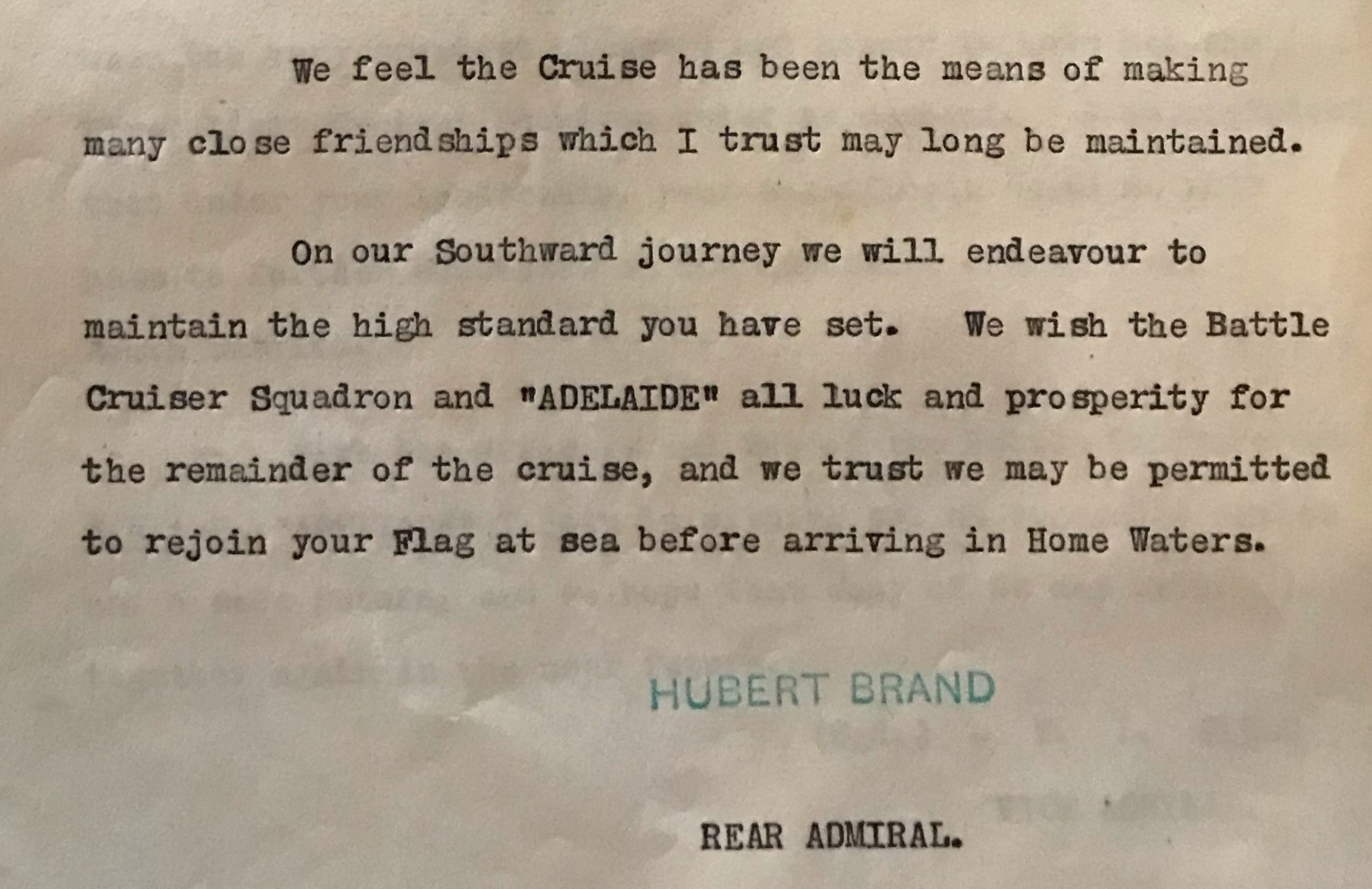
Operating as two different squadrons, they would not reunite until 28 September 1924 for the last part of the voyage home. Although their courses did not completely diverge until Panama, they sailed separately and mostly out of sight of each other.
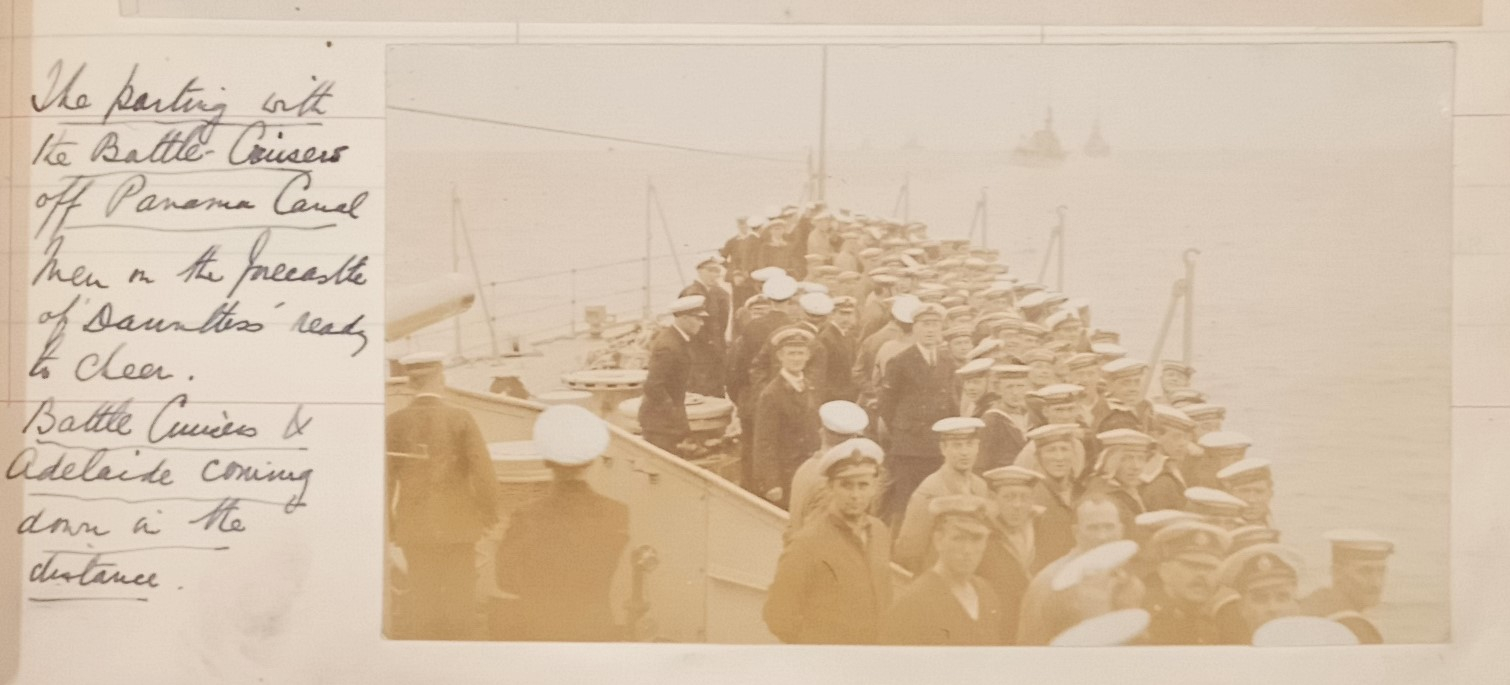
"We parted company with the B.C [battle cruisers] Saturday 12 July; the day after we left San Francisco. When we parted with them, we steamed down quite close and cheered each ship as we passed" (Captain Round Turner, RNM 2015/175/4)
Battlecruisers: 23 – 30 July 1924
On 22 July 1924, HMAS Adelaide, who had gone ahead of the battlecruisers arrived at Balbao, Panama to refuel, with HMS Hood and HMS Repulse arriving a day later. The canal had been completed only 10 years before, cutting out the long route around South America for ships and costing the French and United States Government an estimated $639 Million (in 1914). The canal was run as a profit-neutral utility, tolls meant to cover the operational costs only; the tolls for the three ships came to $22,399.50.
"About 9 a.m. Hood weighed anchor and proceeded up the canal, to be followed a couple of hours later by the Repulse. We proceeded under our own steam until we arrived at the first lock, the Miraflores lock. Here the ship is raised 55 feet in two stages from sea level to the level of the Miraflores Lake... Almost before we had come to rest inside the first lock, the gates were closing behind us and, immediately they were properly closed, the lock began to fill at a surprising rate." (Wilfred Woolman, RNM 1999/31)
The six locks through the canal were only 54 inches wider than HMS Hood’s greatest beam (width) but the ship did not touch the sides. The 51-mile trip through the canal took them 10 hours and on exiting they sailed for Kingston, Jamaica.
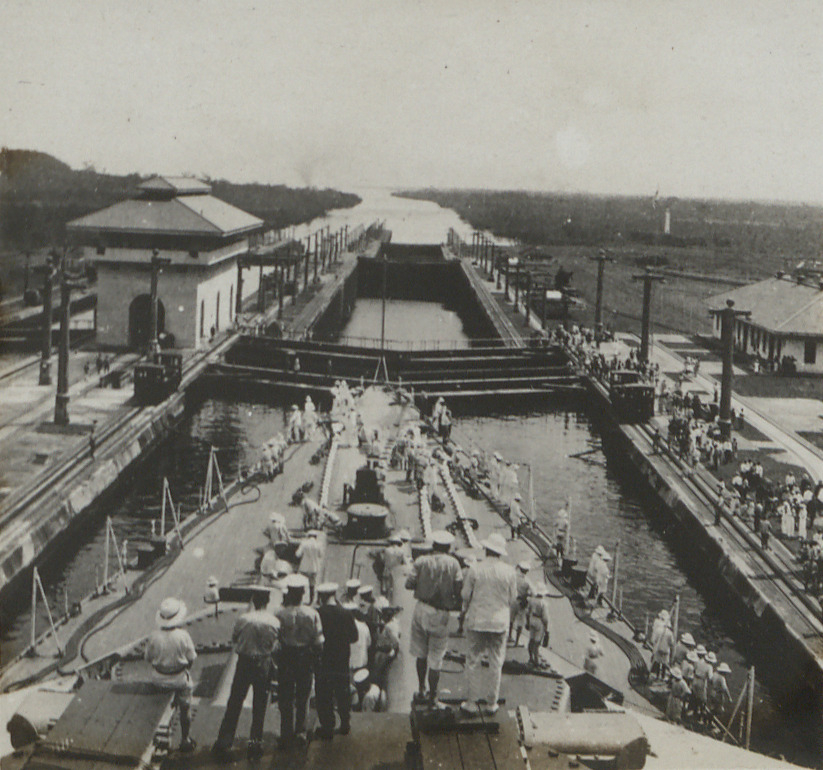
Jamaica: 26 July 1924
The battlecruisers and HMAS Adelaide anchored off Port Royal, 40 minutes by picket boat across the harbour to the capital at Kingston, where a triumphal arch had been set up on the landing stage. Jamaica had been home to British settlers since 1655 and a major base for the Royal Navy’s North American and West Indies station up until the naval dockyard at Port Royal closed in 1905, when Halifax, Canada became the primary base.
Jamaica had a long history of sugar plantations operated with slave labour until 1838. The slave trade was abolished in 1808 but the total abolition of slavery wasn’t passed until 1834, with it demanding complete emancipation for slaves within four years. Freedom though did not bring economic or political equality, and it was not until 1898 that the People’s Convention was established to encourage political participation for Black men and women. The country suffered further from an earthquake and subsequent fire in 1907 which killed over a thousand people and heavily damaged the centre of Kingston.
At the time of the squadron's visit, it was a British Crown Colony with Sir Leslie Probyn as the Governor, and it had its own administration, the Legislative Council of Jamaica. Minor constitutional changes had been proposed in 1922 and were still under discussion by the political parties, such as the power of veto in financial matters. Some, including the Jamaican barrister J. A. G. Smith wanted more substantive change. The local population had also been affected by land grants made under the 1919 Overseas Settlement Scheme. The scheme which lasted until 1922, was to assist discharged personnel returning home from the Great War and offered free passage to ex-service men and women and their dependents. In 1922, following a visit of the Under-Secretary of State for the Colonies there were suggestions of strained relationships due to the settlement raised in the British parliament (House of Commons Debate 09 May 1922).
Despite this complex history, the Jamaicans welcomed the British ships and they put on a range of sporting events. The Cricket Field team from HMS Hood and HMS Repulse met an All-Jamaica combination team, the Jamaican team winning by an innings and 26 runs.
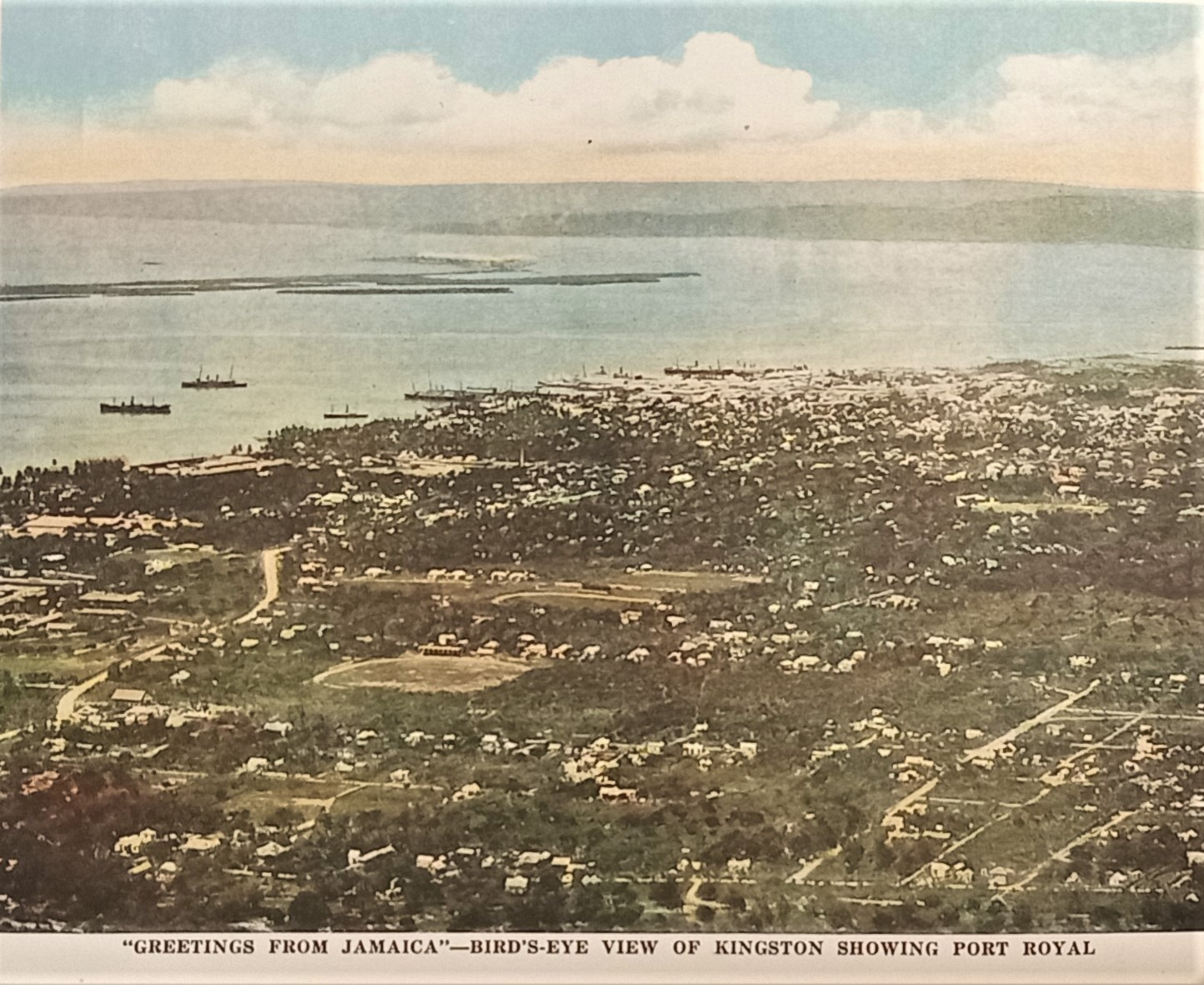
The usual formalities were also observed, with a ceremonial march, and a lunch was given by the Jamaica Club. There was a feeling amongst the crew that they were on their way home. In his diary, Wilfred Woolman wrote:
"Now we are in the Atlantic, we feel we just want to push on home and every day's delay chafes." (Wilfred Woolman)
HMS Hood, Repulse and HMAS Adelaide left Jamaica 30 July 1924, sailing for Halifax, Eastern Canada.
Light Cruiser Squadron, At Sea: 12 – 26 July 1924
The light cruisers were sailing for Peru. HMS Delhi was the flagship of the light cruiser squadron with Rear Admiral Sir Hubert Brand in command of the squadron, and Captain James Murray Pipon in command of the ship. At sea the usual shipboard routine continued along with training exercises; this included anti-aircraft firing, which they could do without stopping and turning, which would have impacted their travel time.
"...it's a pleasant enough life in its way...we see nothing but the sea, flying fishes, porpoises & whales & turtles... I think the men are supremely happy, just at the moment; it is after dinner now, they are having a dance on the quarter deck and our jazz band is playing. There is one thing I shall always be particularly glad of, that I have had a very fine lot of men to go around the world with. I have never known anything equal to our men... the ship has always been one of the cleanest & smartest & they have always done well in the sports & games. There have been no drunks only a cheerie bonhomie all through... I can't say enough of them, I just love them & I am so proud to be Captain of the whole box of tricks". (Captain Round Turner, RNM 2015/175/4).
Callo, Peru: 26 July 1924
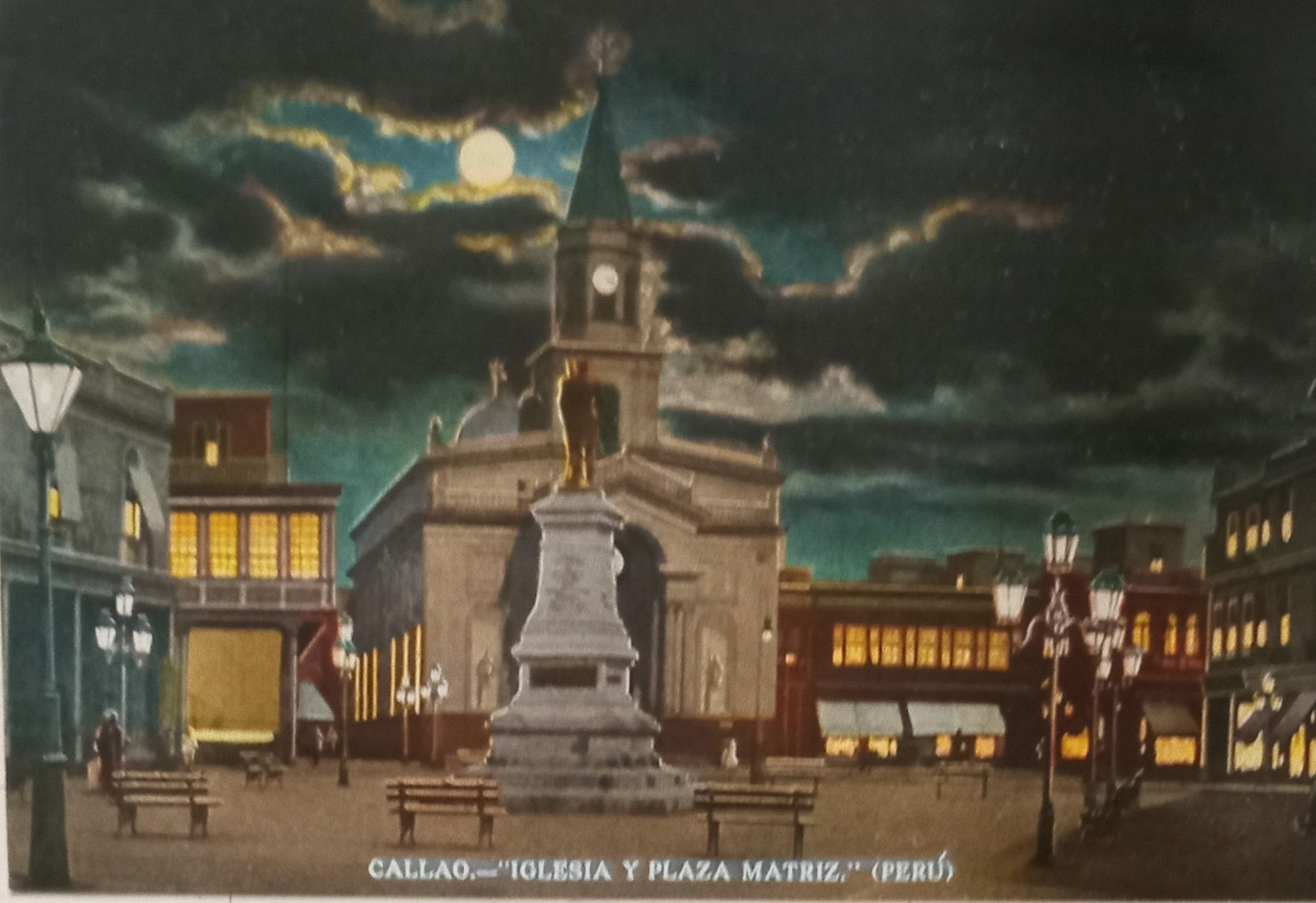
The light cruisers were met by the Peruvian cruiser General Bolognesi who saluted the Admiral’s flag. 28 July was Peruvian Independence Day, which commemorates the liberation of Peru from Spain by José de San Martin, and the ships were dressed overall. The Rear Admiral and senior officers accompanied the President, Augusto Bernardino Leguía y Salcedo to the Te Deum held in the cathedral. The Te Deum is a traditional catholic hymn of thanksgiving. The President also dined with Rear Admiral Brand on HMS Delhi. Some of crews who were not involved in the formalities took the central railway up to La Cima, 4,835m above sea level, the highest railway in South America. The light cruisers stayed here until 31 July when they sailed for Coquimbo (Chile).
Come back next month to hear about the next leg of the squadron’s journey, with the Battlecruiser Squadron in Halifax, Canada and the light cruiser squadron going around Cape Horn, South America.
In the meantime, if you want to learn more about the British Special Service Squadron you can search our Collection:
Sources and further reading
Black History Month. History of Jamaica. Published online 27/06/2020.
Family papers of Vice Admiral Murray Pipon, KBE (Private collection).
Jemmott, Jenny. A History of Kingston: the parish histories of Jamaica Project. Sourced online 16 July 2024
Marquiss-Munro, Phyllis. President San Francisco Women’s Press Club. The Visit of the British Fleet. The WASP. July 19, 1924. Retrieved online and quoted by kind permission of The Museum of the City of San Francisco.
Morgan, Kenneth. Creating an English Jamaica, 1655–1775 published online by Cambridge University Press: 23 November 2023.
RMM 2013/104/33/320, the album of Richard Attwood.
RMM 1982/87a/306, the album of Royal Marine, M.L. Lewis.
RNM 1987/406/9, souvenir of the British special service squadron world cruise 1923-1924; photographic booklet about Kingston, Jamaica.
RNM 2015/175/4, letters of Captain Charles Round-Turner to his wife. 1923-1924.
RNM 1999/31. Woolman, Wilfred. Typescript transcription of a diary kept by Wilfred as Schoolmaster in HMS Repulse during the world cruise of the Special Service Squadron, 27th November 1923 - 29th September 1924. Transcript by his son Aubrey Woolman.
Scott O'Connor, Vincent Clarence. The Empire Cruise. Riddle, Smith & Duffus, 1925.
The Kingston Gleaner Tuesday, July 29, 1924, sourced online 16 July 2024.
Vivian, John. The Empire Cruise published in The Royal United Service Institute Journal, 1926. P318.